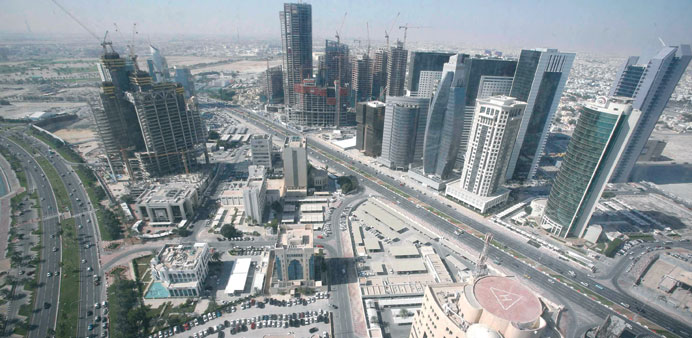|
|
Five years ago, inflation in Qatar soared into the double digits after the country spent heavily on hosting the 2006 Asian Games. Now, with another government spending spree and an even bigger sports event looming, inflation is on the rise again.
The country of 1.9mn people plans to spend about $140bn to build stadiums, roads, railways, a new airport, a seaport and other infrastructure before it hosts the 2022 soccer World Cup.
Government officials and company executives insist they have learned from the last inflation fallout and will be able to avoid another one, partly because they have given themselves more time to carry out the construction.
“In 2006, we saw a very different situation compared to what we have now. We had to execute all the projects within a tight time-frame, and were faced with a very sudden inflow of people into the country,” R Seetharaman, chief executive of Doha Bank, Qatar’s fifth-largest bank by market value, told Reuters.
“Now, we have enough time to execute these projects; it will be done gradually over the next five years. The time frame will help in acting as a stabiliser in preventing inflationary issues.”
Qatar’s inflation rate hit a record 15.2% in 2008, partly because of a building boom for the Asian Games; logistical problems and bottlenecks, including difficulties in bringing enough building materials into the country, caused costs in the economy to spiral.
In a sense, the global financial crisis came to Qatar’s rescue. Inflation fell rapidly as housing rental prices plummeted in response to the global turmoil, and Qatar actually experienced deflation — falling consumer prices — in 2009 and 2010, underlining how vulnerable the wealthy gas-exporting economy is to global trends.
In the last few months, however, the spectre of high inflation has reappeared. The year-on-year rate jumped to 3.6% in March, from 3.2% in February and 2.6% in December. A major reason for the rise was a rebound in housing rents, which account for about a third of consumer expenses; they gained 5.5% in March.
One factor behind the inflation surge appears to be increased government spending on social welfare. In September 2011 the Qatari government boosted basic salaries and social benefits for state civilian employees by 60%.
Inflation would be higher at present if Qatar had been quicker to get its infrastructure projects into gear after winning the right to host the World Cup nearly 2-1/2 years ago. The government has been slower to award contracts than many companies had expected — disappointing many foreign businessmen, but limiting upward pressure on prices.
“The two-year delay has had the effect of controlling inflation,” said Abdulaziz al-Ghorairi, senior vice-president and chief economist at Commercialbank Capital in Doha.
This year, however, infrastructure spending looks set to ramp up in earnest. Plans call for state expenditure to increase 18% to QR210.6bn ($57.8bn) in the 2013/14 fiscal year that started on April 1, and to stay at about this year’s level until 2017, HE the Finance and Economy Minister Yousef Hussein Kamal said this month.
In January, the International Monetary Fund’s mission chief for Qatar told Reuters that the economy’s ability to absorb heavy infrastructure spending was an issue, though he added there were no concerns about the economy overheating for the moment.
One of the government’s defences against inflation is its ability to regulate prices. In a statement in December, the government said it would use regulatory powers to prevent traders from imposing “unjustified” price hikes on consumers.
In September 2011, the Ministry of Business and Trade was directed to establish a committee to monitor prices of goods, in order to curb arbitrary price increases following that year’s state salary hike.
Another weapon against inflation is monetary policy. In March, the central bank introduced quarterly issues of riyal-denominated bonds, giving it a tool to manage excess funds in the banking sector.
The central bank governor told Reuters this month that these issues could be adjusted flexibly. Officials and some analysts say such tools will be sufficient to avoid another burst of double-digit inflation in the next few years.
“We do foresee inflation going up, but we expect it to remain in the single digits,” Ghorairi said.
Others are less sure, given Qatar’s heavy dependence on imports — except for energy, most of the basic goods which it consumes are imported — and the fact that the Qatari riyal is pegged to the US dollar.
The peg constrains Qatar’s ability to raise interest rates to fight inflation, and prevents it from appreciating its currency to offset any rise in import costs.
“I don’t think there is much the central bank can do about the kind of inflation Qatar faces from population growth and project spending,” said a Doha-based economist at a major financial institution.
A burst of inflation could disrupt the infrastructure programme by raising the costs and crimping the profit margins of companies building the projects.
However, the impact would probably be bearable for Qatar’s affluent population of local citizens, who number only about 250,000 of the total population of 1.9mn.
“Who is really damaged by single-digit inflation? Most corporates have cost-of-living adjustments, and people who own assets see the benefit of it,” said Steve Troop, chief executive of Doha-based Barwa Bank, adding “3.6% isn’t the end of the world in a place where people don’t pay tax.”



